Why does she have to be a real nun? (Pope Joan was never a nun in any case, and Stendhal wasn't looking at the PMB).
Is the Pope a real Pope? He doesn't look much like Nicholas V. Is the Emperor a real Emperor? He doesn't look like Frederick III (nor does he look like Sigismund, whose beard was much shorter). Is the Empress Eleanor of Portugal?
No, none of these are depicting real people. They are fantasy figures, played in ludic space, in an intimate world of imagination. The cards are not tools of diplomacy or public rhetoric. They are custom-made versions of stock figures in a game played in private.
I think the Popess is best explained as whom the Pope is married to, i.e. the Church. That this stock figure in other contexts could arouse indignation as "Pope Joan", like it did for the author of the Steele Sermon, is understandable, and explains her suppression in various places.
Re: Stendhal, "papesse Jeanne", and the "cojononon"
12Phaded wrote,
On your second sentence above, Phaeded, yes, Stendhal does mention tarot in Charterhouse:
Another translation, which I found at the library, by C. K. Scott Moncrieff (1925), p. 105, has:
About your first sentence: that was my point, in bringing up de Brosses' discussion of Papesse Jeanne (de Brosses' term), which Ross quoted. We do have to take into account Stendhal's lens. It is in virtue of taking it into account that we don't know if Stendhal's interpretation of the Papesse as Jeanne is the result of the lens or of what he was told in Milan. We just don't know. That's why I say (in reply to Ross) it's a puzzle .And of course Ross is right in that we have to account for the lens through which a Frenchman saw things (I wonder if he mentions tarot in his Charterhouse of Parma? Will have to reread….)
On your second sentence above, Phaeded, yes, Stendhal does mention tarot in Charterhouse:
The translation I found in Google Books (which I quote in my translation of Andrea's "Tarot in Literature IV", http://www.associazioneletarot.it/page. ... 91&lng=ENG) has it on p. 91:Or maintenant ce chanoine faisait tous les soirs la partie de tarots de la baronne Binder...
This Canon played tarot every evening with Baroness Binder...
Another translation, which I found at the library, by C. K. Scott Moncrieff (1925), p. 105, has:
Charterhouse is well worth re-reading, but not on that account. Tarot is only mentioned that one time. Other card games mentioned in the novel are tricci-tracci (or however it's spelled), and whist.Now at present this Canon was in the habit of going every evening to play tarocchi with Baronessa Binder...
Re: Stendhal, "papesse Jeanne", and the "cojononon"
13Ross wrote
When the tarot Popess--the word plus the image, i.e. an emblem--appeared, therefore, it was something new. Once there, it would have been easy to read into it whatever one's cultural lens suggested: the Church as the Pope's wife, Pope Joan, or, for those who knew, Popess Manfreda. There was no rule that it had to be a generalized entity; but if you insist, then "a woman so full of the Holy Spirit as to be worthy of replacing the Pope in a new age" (or "a woman so wise-seeming, and also so clever at disguising herself, that she could get herself elected pope"). In any case, the emblem's various interpretations after the fact, as shaped by one's "lens", are different from the intentions of those responsible for its introduction. It could have started as a particular person, or group, who embodied certain qualities so well as to represent them. Alternatively, the inventor, or an inventor, of the tarot might have been motivated simply by the consideration that if there was an Empress as well as an Emperor, there should be a Popess, representing the Church, as well as a Pope, even though such a move would be subject to misinterpretation. That's one theory for how the Popess came to be in the tarot, to be sure the simplest; but it is only one theory among several, and human minds do not always, or even mostly, work in the simplest ways.
Well, I can't let that pass! I don't see where the Popess as the Church was a "stock figure" until considerably after the tarot was invented. It was true, before the tarot's invention, that the Pope was married to the Church, but the Church wasn't called "Papessa"; and it wasn't, as far as any one knows, depicted as a lady in a tiara, the counterpart of the Pope, until about 1523 Paris, I think is what you found. That is right after Cranach's 1522 woodcut in a Luther Bible of the Church of Rome, or perhaps the Pope, doubling as the Whore of Babylon, a woodcut curiously labeled "Johannis": http://commons.wikimedia.org/wiki/File: ... tament.jpg).I think the Popess is best explained as whom the Pope is married to, i.e. the Church. That this stock figure in other contexts could arouse indignation as "Pope Joan", like it did for the author of the Steele Sermon, is understandable, and explains her suppression in various places.
When the tarot Popess--the word plus the image, i.e. an emblem--appeared, therefore, it was something new. Once there, it would have been easy to read into it whatever one's cultural lens suggested: the Church as the Pope's wife, Pope Joan, or, for those who knew, Popess Manfreda. There was no rule that it had to be a generalized entity; but if you insist, then "a woman so full of the Holy Spirit as to be worthy of replacing the Pope in a new age" (or "a woman so wise-seeming, and also so clever at disguising herself, that she could get herself elected pope"). In any case, the emblem's various interpretations after the fact, as shaped by one's "lens", are different from the intentions of those responsible for its introduction. It could have started as a particular person, or group, who embodied certain qualities so well as to represent them. Alternatively, the inventor, or an inventor, of the tarot might have been motivated simply by the consideration that if there was an Empress as well as an Emperor, there should be a Popess, representing the Church, as well as a Pope, even though such a move would be subject to misinterpretation. That's one theory for how the Popess came to be in the tarot, to be sure the simplest; but it is only one theory among several, and human minds do not always, or even mostly, work in the simplest ways.
Re: Stendhal, "papesse Jeanne", and the "cojononon"
14Tarot is also the earliest witness to an association of Death with the number 13; perhaps it is because of Tarot that this association arose in France (in addition to already being considered an unlucky number to have seated at a table, attested in the late 16th century). So my eyebrows raise a little less when I think that Tarot might also be the earliest witness to an allegory of the Church as a woman with a papal crown.mikeh wrote: I don't see where the Popess as the Church was a "stock figure" until considerably after the tarot was invented.
On the other hand, we have Pope Joan (without baby) being a captive of Love as early as c. 1480, so one might take that interpretation as contemporary enough. But the nun problem remains.
Of course my preferred Ur-Tarot doesn't have a Popess (or an Empress), so the potential question of "what did the inventor or the sequence intend by including her?" doesn't arise. It becomes a secondary question of "what did the inventor of those female figures mean by them?". I think it was a courtly or luxury innovation, as for instance in the Visconti decks. They tend to put females into the deck more, e.g. in the Cary Yale, the female as charioteer, as the figure on the World. So it makes sense to me they invented the female papi as well, Popess and Empress.

Re: Stendhal, "papesse Jeanne", and the "cojononon"
15Ross wrote,
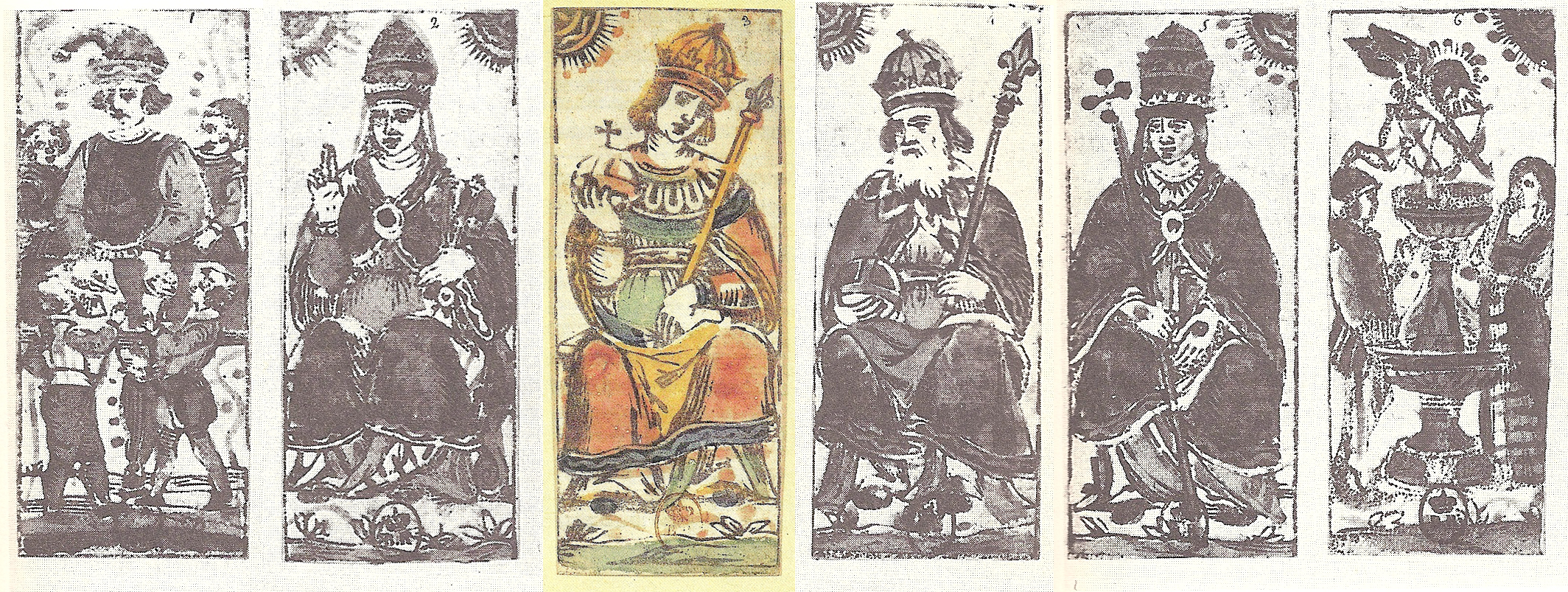
That they all have the same value, with a doubling of each figure, is a singularity that goes against all precedent. I admit, however, that your proposal is possible, and that the Bolognese have preserved these cards and manner of play thanks to their famous conservatism. It is possible that the Visconti took the more effeminate ones and turned them into women, giving the Papal one a nun's outfit and removing all of her papal gear except the tiara.
Another scenario is also possible: the invisible hand of the Church is at work here. In 1507, after over half a century of relative autonomy, Bologna falls under the heel of the Papacy, which is doubly resentful because of the populace''s insolence in toppling Michelangelo's statue of Pope Julius and giving it to the cannon-maker Alfonso. The Popess, because of the implication that she might be Joan or the Pope's mistress, is an abomination. So they change her to an effeminate-looking man, another Pope--although leaving some of the wimple--and for symmetry also change the Empress to an effeminate-looking man as another Emperor. That way the change is merely a modification of what came before, not something totally new. And so it remains for three centuries, the Bolognese stubbornly holding onto the game they think they invented (on that, see Andrea's "Sermons of Giusti"). Similar pressure occurs in Florence, except that there the Church, while strong, has less direct power. Instead of changing the tarot, another deck called Minchiate, with its effeminate Grand Duke, comes to the fore. In places where the Church has even less power, such as Ferrara, Venice, Milan and France, the Popess remains.
I myself think this latter alternative is more realistic.
Ross wrote,
Also, why would the designer have been so provocative as to leave the tiara, inviting the inevitable jokes about Pope Joan and the mothers of the current Pope's favorite children? There are less provocative ways of feminizing a "papa", e.g. by making her fully a nun, say an abbess. Either the designer was very naive, didn't mind offending the papacy (i.e. the institutional church), or had something to say that overrode such concerns--or both of the latter.
Ah yes, your ur-Tarot. I assume you mean the one you defended in the "Bologna Sequence" thread. Perhaps I should say something about these "four papi". It seems to me strange that in a milieu of trick-taking games in which the highest card takes the trick, and in which in particular the trumps are otherwise unique personalities, we have, in the very first deck, in slots 2-5, four figures all with the same value, called only "papi", but with two of them looking Imperial, the other two looking Papal. The first Imperial one looks rather feminine in comparison with the other; and the same is true of the first Papal one, even though they are both young (oddly, for a Pope); the first one has the hint of a wimple, a female form of dress (http://en.wikipedia.org/wiki/Wimple). Here is your composite image, from "Bolognese Sequence", viewtopic.php?f=12&t=334&p=4169&hilit=c ... tism#p4147Of course my preferred Ur-Tarot doesn't have a Popess (or an Empress), so the potential question of "what did the inventor or the sequence intend by including her?" doesn't arise. It becomes a secondary question of "what did the inventor of those female figures mean by them?". I think it was a courtly or luxury innovation, as for instance in the Visconti decks. They tend to put females into the deck more, e.g. in the Cary Yale, the female as charioteer, as the figure on the World. So it makes sense to me they invented the female papi as well, Popess and Empress.

That they all have the same value, with a doubling of each figure, is a singularity that goes against all precedent. I admit, however, that your proposal is possible, and that the Bolognese have preserved these cards and manner of play thanks to their famous conservatism. It is possible that the Visconti took the more effeminate ones and turned them into women, giving the Papal one a nun's outfit and removing all of her papal gear except the tiara.
Another scenario is also possible: the invisible hand of the Church is at work here. In 1507, after over half a century of relative autonomy, Bologna falls under the heel of the Papacy, which is doubly resentful because of the populace''s insolence in toppling Michelangelo's statue of Pope Julius and giving it to the cannon-maker Alfonso. The Popess, because of the implication that she might be Joan or the Pope's mistress, is an abomination. So they change her to an effeminate-looking man, another Pope--although leaving some of the wimple--and for symmetry also change the Empress to an effeminate-looking man as another Emperor. That way the change is merely a modification of what came before, not something totally new. And so it remains for three centuries, the Bolognese stubbornly holding onto the game they think they invented (on that, see Andrea's "Sermons of Giusti"). Similar pressure occurs in Florence, except that there the Church, while strong, has less direct power. Instead of changing the tarot, another deck called Minchiate, with its effeminate Grand Duke, comes to the fore. In places where the Church has even less power, such as Ferrara, Venice, Milan and France, the Popess remains.
I myself think this latter alternative is more realistic.
Ross wrote,
Assuming your ur-Tarot, there is indeed the problem of the radical change in outfit, as perhaps you were pointing out: the nun's habit, which is unlike that of other early Popesses--actually, there aren't many we can see, just the Cary Sheet, the Rosenwald, the Catelin Geoffrey, and the uncut sheets in Budapest and New York. None looks like the PMB's nun. Why such a radical change, and the sad expression, unless the designer were trying to say something the others weren't (http://upload.wikimedia.org/wikipedia/c ... popess.jpg)?But the nun problem remains.
Also, why would the designer have been so provocative as to leave the tiara, inviting the inevitable jokes about Pope Joan and the mothers of the current Pope's favorite children? There are less provocative ways of feminizing a "papa", e.g. by making her fully a nun, say an abbess. Either the designer was very naive, didn't mind offending the papacy (i.e. the institutional church), or had something to say that overrode such concerns--or both of the latter.
Re: Stendhal, "papesse Jeanne", and the "cojononon"
16The PMB's possible dates fall under four popes - Nicholas V, Callixtus III, Pius II and Paul II - none of whom were know for having fathered children as Pope (or immorality in general), so I don't know what you are referring to here. Unless you are thinking that by Alexander VI's time the PMB Popess was still circulating widely.mikeh wrote: Also, why would the designer have been so provocative as to leave the tiara, inviting the inevitable jokes about Pope Joan and the mothers of the current Pope's favorite children? There are less provocative ways of feminizing a "papa", e.g. by making her fully a nun, say an abbess. Either the designer was very naive, didn't mind offending the papacy (i.e. the institutional church), or had something to say that overrode such concerns--or both of the latter.
But my main problem with your reasoning is why you continue to think that the Church had anything to say about a private commission of an intimate game for the Sforza family. Do you imagine that there was an inquisitor casting a watchful eye over everything the noble families did, censoring material he didn't like? This is the sort of scenario that your comments, along with those of Huck and Phaeded, often evoke. That the Church was up in everybody's most intimate business all the time.

Re: Stendhal, "papesse Jeanne", and the "cojononon"
17Both of the 17th century Alla Torre "Popes" do indeed look feminine, especially the one mislabeled "2" (with the keys). I don't see much feminine in the beardless Emperor though, just a youth. One could argue that this deck has two Popessess, or in fact three - the figure on the left in the Star has morphed into a Popess by the 17th century as well (far left card), and survives to the present in the Bolognese trumps (she loses her papal garb between Alle Torre (17th century) and Al Leone (18th century), and moreso as time goes on, but the triple tiara remains).mikeh wrote: Ah yes, your ur-Tarot. I assume you mean the one you defended in the "Bologna Sequence" thread. Perhaps I should say something about these "four papi". It seems to me strange that in a milieu of trick-taking games in which the highest card takes the trick, and in which in particular the trumps are otherwise unique personalities, we have, in the very first deck, in slots 2-5, four figures all with the same value, called only "papi", but with two of them looking Imperial, the other two looking Papal. The first Imperial one looks rather feminine in comparison with the other; and the same is true of the first Papal one, even though they are both young (oddly, for a Pope); the first one has the hint of a wimple, a female form of dress (http://en.wikipedia.org/wiki/Wimple). Here is your composite image, from "Bolognese Sequence", viewtopic.php?f=12&t=334&p=4169&hilit=c ... tism#p4147

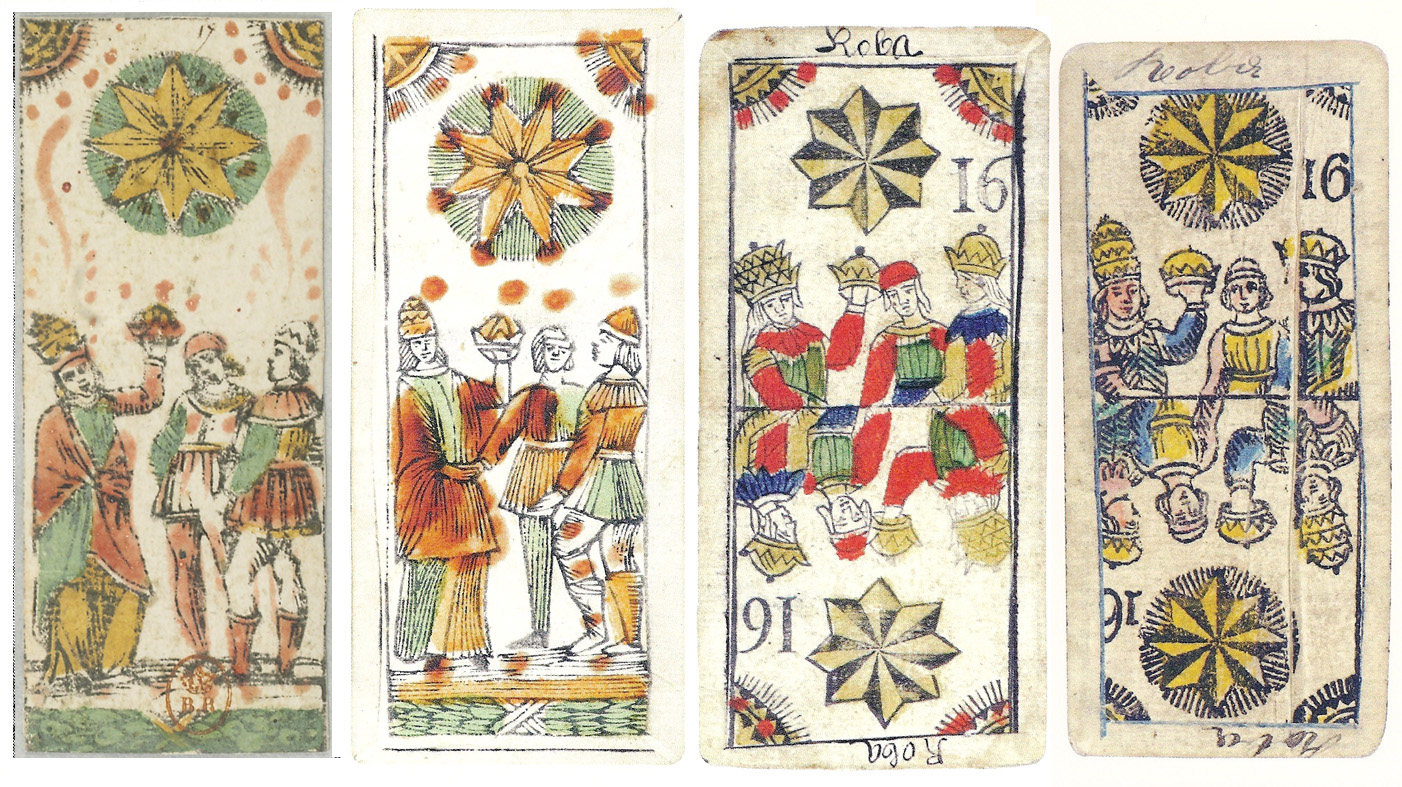
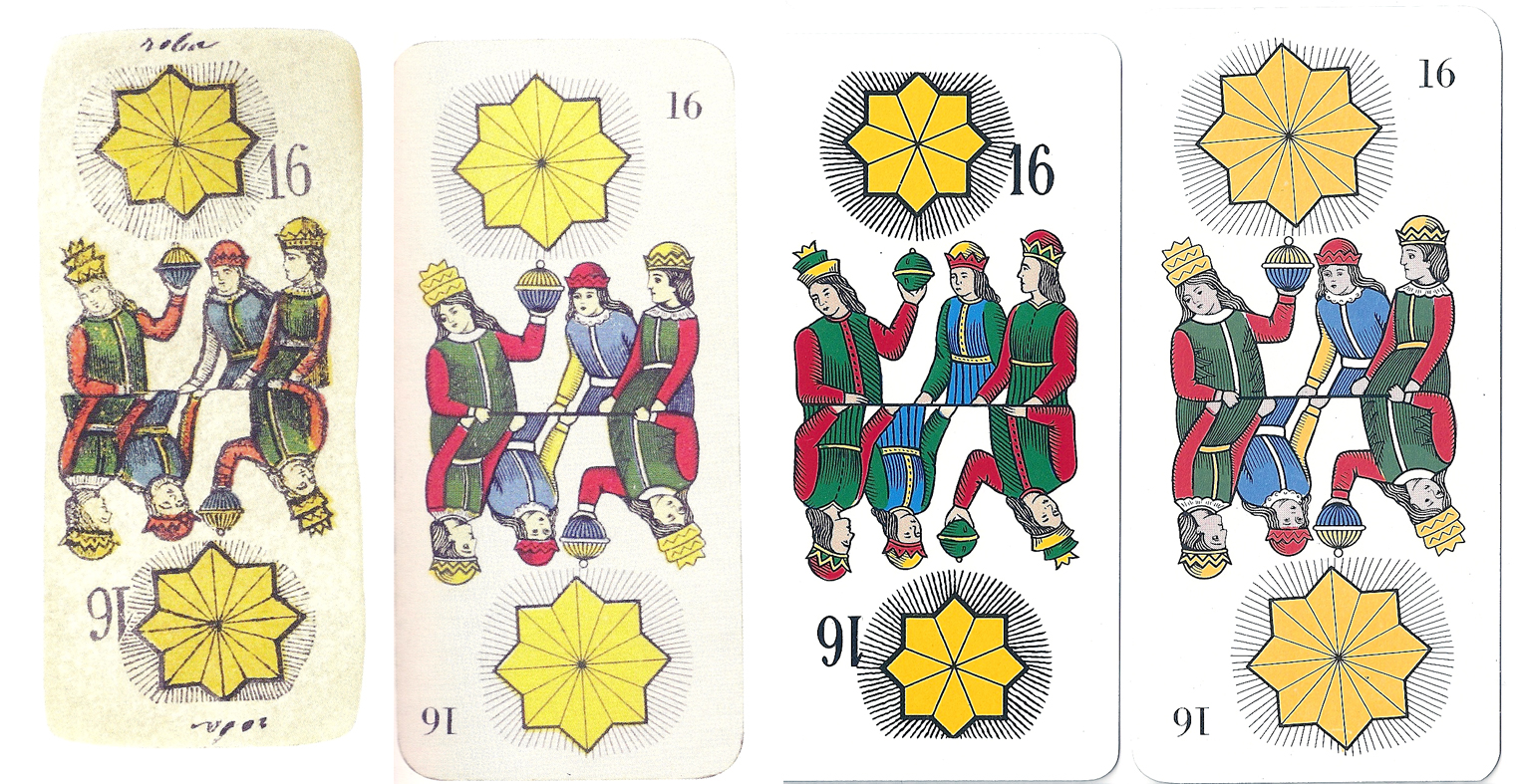
http://www.rosscaldwell.com/images/taro ... astar1.jpg
http://www.rosscaldwell.com/images/taro ... astar2.jpg
Unfortunately we don't have the lower cards of the BAR sheets to compare papi, but from the figures on the Star we can be confident that around 1500 this figure was a king and not a Popess.
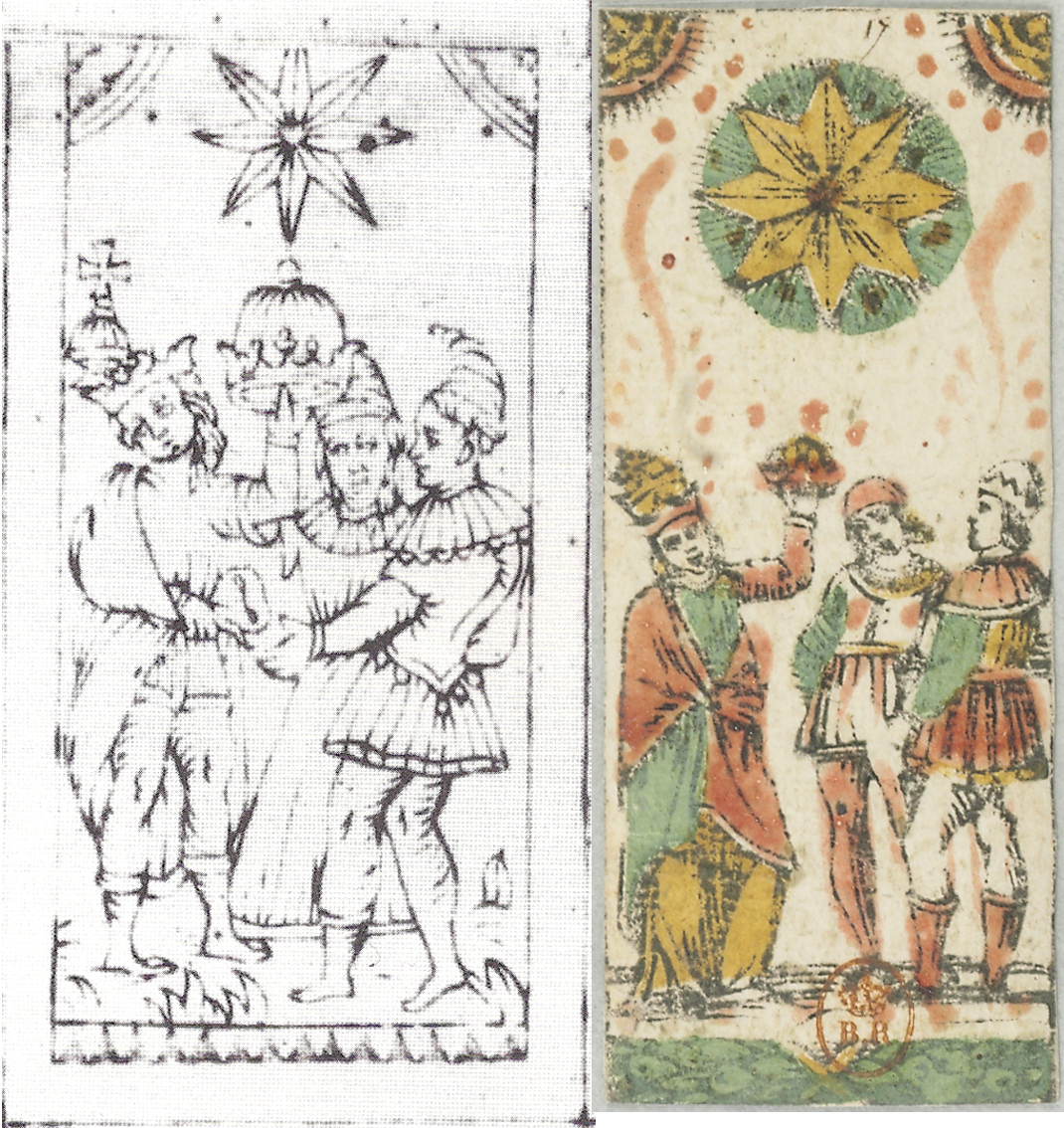
http://www.rosscaldwell.com/images/taro ... recomp.jpg
We can also compare the Mondo card, where the figure standing on the world in the BAR is no clear mythological figure, but by Alla Torre's time he had morphed very clearly into Mercury.
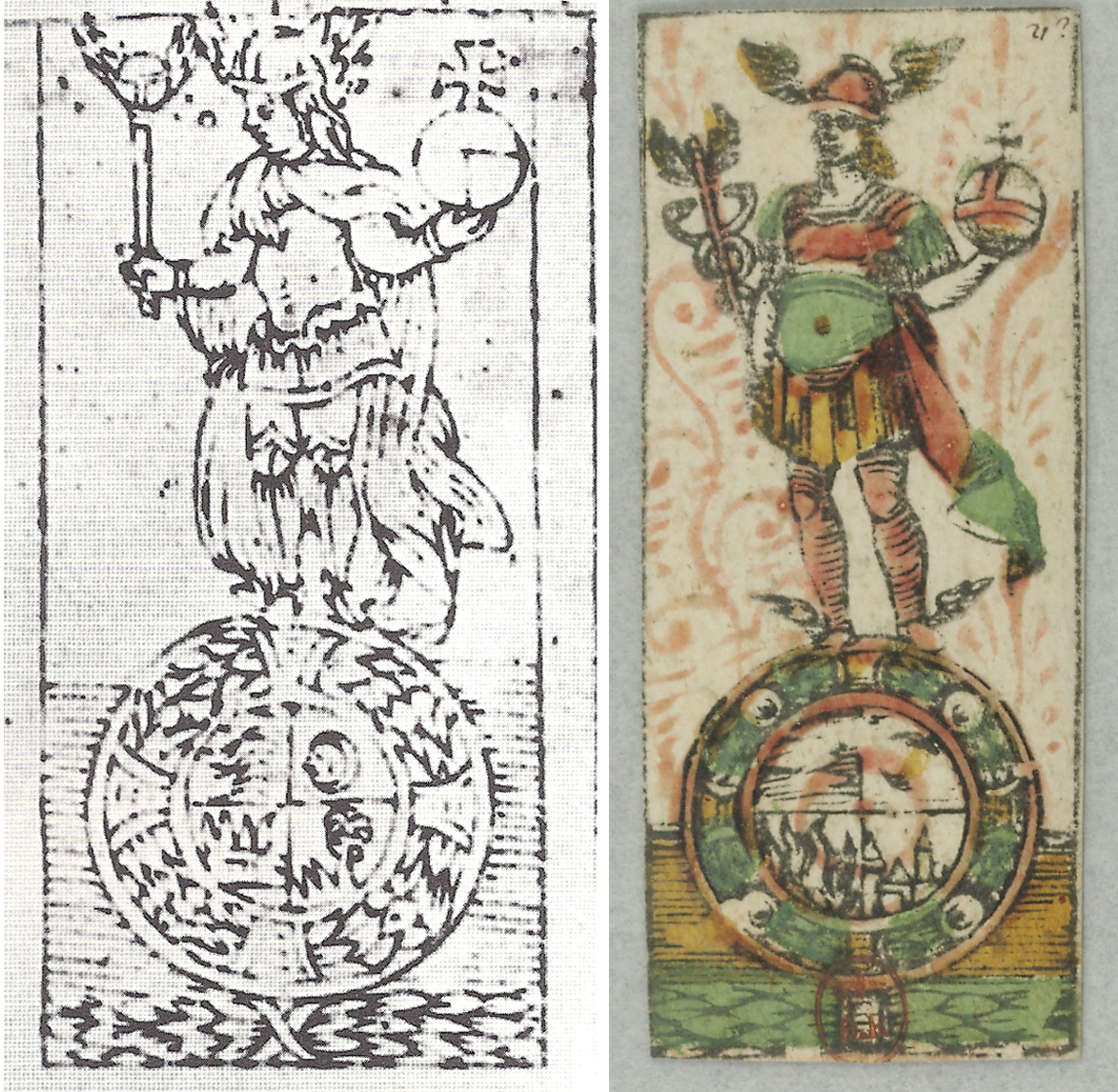
http://www.rosscaldwell.com/images/taro ... docomp.jpg
These kinds of changes make me wary of projecting standard patterns like the Alla Torre back into the 15th century. Its primary value for my analysis is that it is single headed and suggests what the Papi looked like before their suppression and transformation into Moors in 1725. But I don't trust the details after two centuries or more, and prefer where possible to rely on what BAR can show me - without granting even that my full confidence.
I have seen a few Popes misleadingly labelled as Pope Joan on the web. Sometimes it is Pope Pius, taken from scenes in the Piccolomini chapel in Siena. I can't find it now, but there was one just taken unaltered. Here is another, on the cover of Donna Cross' book "Die Päpstin", from the scene where he is canonizing Catherine of Siena. Look how the artist has altered the Pope to look like a woman, altering the face, hair, and robe to look like breasts are beneath (and put the feminine Venus symbol on the book):
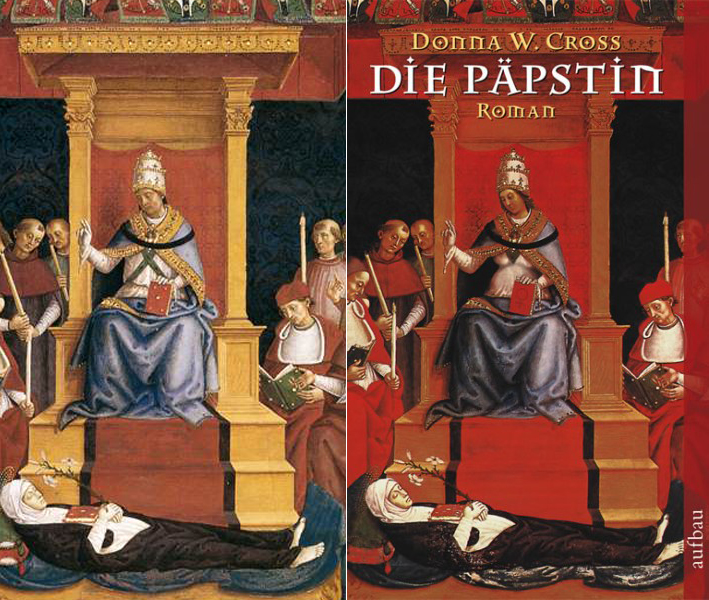
http://www.rosscaldwell.com/images/taro ... sscomp.jpg
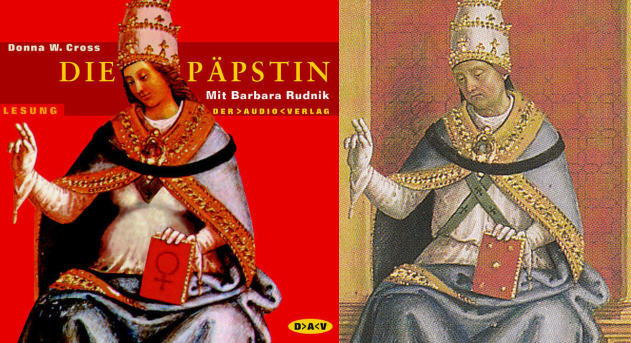
http://www.rosscaldwell.com/images/taro ... uscomp.jpg
So Popes can look feminine enough to be mistaken for women, or people can be easily convinced that it is a woman.

Re: Stendhal, "papesse Jeanne", and the "cojononon"
18I have to agree with MikeH here – “I don't see where the Popess as the Church was a "stock figure" until considerably after the tarot was invented.” As a variation of Faith, however, holding the cross-topped staff, she has also been taken out of context of the Virtue series one finds in the CY deck. And no, not a “real nun” but the earliest known Papess is nonetheless dressed in the specific garb of a real order, Franciscan. These two changes are the key to this card and dated to the PMB, until there is contrary evidence (Stendhal is an interesting historical footnote but hardly germane to the original meaning of this card).Why does she have to be a real nun?...Is the Pope a real Pope? He doesn't look much like Nicholas V. Is the Emperor a real Emperor? He doesn't look like Frederick III (nor does he look like Sigismund, whose beard was much shorter). Is the Empress Eleanor of Portugal? …The cards are not tools of diplomacy or public rhetoric. They are custom-made versions of stock figures in a game played in private.
Sforza rebuilt an Augustinian church right after his accession (Santa Maria Incoronata, a modest, odd double church – one side for him and one for Bianca) and eventually made his brother archbishop of Milan in 1453, who also happened to be Augustinian and was buried in that very church. So again, why Church-as-Franciscan instead of any other mendicant order, such as the Augustinians? To elaborate on the answer I already provided above: the new regime needed the starved populace to embrace the simple Franciscan ideals of poverty as the embattled Sforza could provide little else besides basic sustenance as he continued to fight for his realm until the Peace of Lodi in 1454. To reiterate my original point: “it was expedient to hold up Faith as Franciscan poverty as an ideal to mitigate expectations from the new regime.” The accessibility of this image to the general populace, versus a narrowly targeted Franciscan group, is underscored by the lack of the full Franciscan habit: The PMB Papess wears the white coif or wimple but the black veil covering, the distinctive headdress of the Franciscan Poor Clares, is missing. Accordingly the Papess figure would seem to indicate an everyman or lay person who has embraced the Franciscan ideals indicated on the belt’s three knots: poverty, chastity, and obedience (ideals that would bode well for the fragile social order Sforza inherited). Papess-as-Faith-of-Church is not “Franciscan” per se but rather speaks specifically to that trinity of mores. The papal tiara is more difficult to explain but no clear definition of it exists – its temporal/rulership nature would belong to the Pope so perhaps the Papess three crowns mimick the three humble knots below and indicate "Church Militant on earth", the "Church Suffering after death and before heaven", and the "Church Triumphant in eternal reward" (stolen from Wiki on papal tiara). And to point to Pope Nicholas V again – his 1447 bull, just three years before Sforza took Milan, deals with the habit to be worn by Franciscan tertiaries – lay persons (and again, Sforza needed the new pope as an ally or at least neutral).
In the CY deck Faith clearly falls in line with the series of virtues with a king-as-vice trampled under foot, such as one finds throughout the Visconti Hours. The figure of Faith in the PMB, while drawing on the iconographic tradition of the Virtue, has been taken out of that series and loses the trampled vice to become something slightly different than just the virtue – Faith has become an allegory of the faithful flock - obviously paired with the Pope. [I have also argued elsewhere that all of the theological virtues have been altered/replaced in the PMB – Hope becomes the Giotto vice counterpart, Despair/hanged man {an unveiled threat from the regime, particularly directed at the combative Trivulzio faction in Milan I would imagine}, and Charity becomes the Pope through whom the “good works of the Church” are directed].
All of the above can now be placed in the context of your objection that the cards were solely meant for private use: “The cards are not tools of diplomacy or public rhetoric.” Given that Sforza presumed to combine the Visconti imprese with his own and issue those combined heraldic symbols – likely for one of the first times in his young regime – in the form of the PMB tarot deck, I’m not sure how the issue of public rhetoric can be avoided. The “stock” images of the trumps dance within a realm explicitly controlled by Sforza, who assumed the continuing legitimacy of the Visconti dynasty, indicated as such by their conjoined imprese littered throughout the deck. Sforza even goes so far as to place his three-ring personal impresa on the Empress and Emperor in the PMB…all while the Emperor was claiming Milan for himself and denying Sforza the imperial rescript he needed for legitimation (again, this work is fundamental here: Gary Ianziti, Humanist Historiography Under the Sforzas: Politics and Propaganda in Fifteenth-Century Milan , Oxford University Press, 1988). The PMB is rhetorically explicit: Sforza was making (illegitimate) political claims via the symbols on the cards, but in fact Sforza never got the imperial investiture through his death in 1466.
No need to cast the issue as one of “inquisition” – it was political or rather “foreign relations”, pure and simple. Sforza’s papal relations are unusually well documented. See for instance: Peter Blastenbrei, “The soldier and his cardinal: Francesco Sforza and Nicolò Acciapacci, 1438–1444”, Renaissance Studies, Volume 3, Issue 3, pages 290–302, September 1989. And consider the facts that Sforza was a papal commander and then later forced out of the Marche by Pope Eugene’s mercenaries; used Filelfo to gain the good will of Pope Nicholas V who in fact helped broker the Peace of Lodi, the diplomacy of which was in fact handled by yet another cleric, the Augustinian Fra Simone da Camerino, who finally brought Venice and Sforza together. Not to mention, again, Sforza made his brother Archbishop of Milan. To deny an utmost awareness of papal relations to the Sforza regime is utterly ridiculous, particularly in regard to something that was essentially circulated paper on which a pope appears.Ross wrote:
Do you imagine that there was an inquisitor casting a watchful eye over everything the noble families did, censoring material he didn't like? …That the Church was up in everybody's most intimate business all the time.
Or are you going to posit that the evidence of trionfi production, for both expensive and cheaper decks, collected by Pratesi does not apply to Milan? In fact Pratesi’s evidence shows trionfi sellers in the same places and times as Sforza:
• “NAIBI SOLD BY SILK-DEALERS” (Pratesi, 03.03.2012) . 1-23-45 the first trioni deck sold in this group was in Ancona [in Sforza’s Marche], with several other decks there going back to 1442. …Of particular interest outside of Tuscany: Pelligrini family from Bergamo [Colleoni’s hometown] who move to to Ancona and are active in the whole Marche region.
• “NAIBI ON SALE” (Pratesi, 27.01.2012). Puri family: “On the cover of the book that will be used below we find a sentence that is noted also in the catalogue of the archive(4) clearly indicating that the owner left Florence and moved to Milan [precisely around the date the PMB would have first appeared:]. "A dì 12 novembre 1451 si partì Maso da Firenze et andò al nome di Dio a Melano."”
These are not instances of a court commissioning a painter (e.g., Ferrara/Sagramoro) in a private sphere, but merchants dealing with the general public. The issue of whether the cheaper decks mimicked the hand-painted luxury decks in all of their details is open to debate but not the diffusion of trionfi in the places where Sforza ruled – the Marche and then Milan.
The PMB cards, as the non-Sforzan coat of arms on the Sword suit indicates (as does the Colleoni’s Bergamo coat of arms on the “fountain” card of later PMB derivations) the deck was gifted to others outside of Milan – they were not strictly for internal private amusement within the Sforza court itself.
Phaeded
PS To kick a dead horse, a late dating of the PMB deck for the Bona wedding (or after) is rife with problems, most notably in the depicted hairstyles that were out of fashion by 1468 and the complete lack of fleur-di-lys; elsewhere Bona is consistently portrayed with a short veil embroidered with fleur-di-lys, never[/] with the coat of arms of Savoy that is supposedly on the Lover’s tent (it is that of Pavia – the original imperial investiture for the Duchy of Milan granted to Gian Galeazzo Visconti made him Duke of Milan and Count of Pavia; Filippo was also Count of Pavia when just the crown prince):
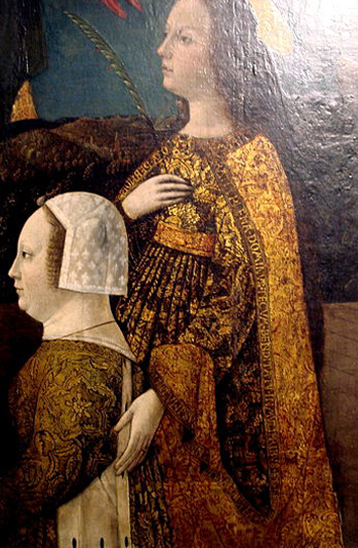
Re: Stendhal, "papesse Jeanne", and the "cojononon"
19I think it is reading too much into the picture to assume that some pro-Franciscan propaganda was being promulgated by the Popess' clothing. For all we know, Bembo could have been a tertiary. I don't think there is any evidence that this particular deck circulated outside the family sphere, or was a gift with any political overtones.
As far as I know, there are only two 15th century versions of the Popess in the Sforza-style decks surviving - the original in the PMB, and the one in the Fournier museum in Vittoria. If the second one was a commission (like Sigismondo's), then the Popess' aspect was changed. She even has a red slipper! What sort of politics does she have to represent?
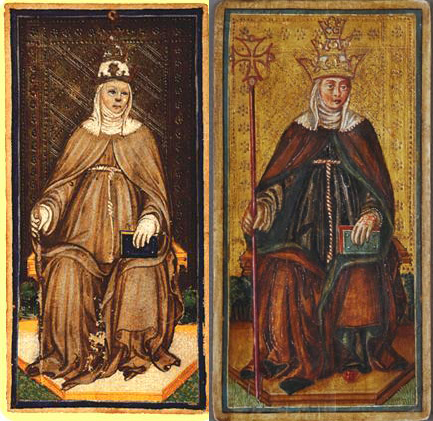
So we can't assume that the Sforza decks were slavish copies of the original, and can't assume that en masse they represent a propaganda effort on Sforza's part. Each deck was unique, even though imitating the style.
As far as I know, there are only two 15th century versions of the Popess in the Sforza-style decks surviving - the original in the PMB, and the one in the Fournier museum in Vittoria. If the second one was a commission (like Sigismondo's), then the Popess' aspect was changed. She even has a red slipper! What sort of politics does she have to represent?

So we can't assume that the Sforza decks were slavish copies of the original, and can't assume that en masse they represent a propaganda effort on Sforza's part. Each deck was unique, even though imitating the style.

Re: Stendhal, "papesse Jeanne", and the "cojononon"
20There was indeed far less need for such an emblem of the Roman Catholic Church, as THE Faith, before the Protestant Reformation prompted the Counter-Reformation. Up to then, the RC Church was the only game in town, except for heresies that the Inquistion was formed to root out and destroy. There was no institutional backing - political backing - for any heresy against the RC Church until the 16th century, except for the Hussite groups, which remained localized in the Czech countries and Bohemia.mikeh wrote:I don't see where the Popess as the Church was a "stock figure" until considerably after the tarot was invented. It was true, before the tarot's invention, that the Pope was married to the Church, but the Church wasn't called "Papessa"; and it wasn't, as far as any one knows, depicted as a lady in a tiara, the counterpart of the Pope, until about 1523 Paris, I think is what you found. That is right after Cranach's 1522 woodcut in a Luther Bible of the Church of Rome, or perhaps the Pope, doubling as the Whore of Babylon, a woodcut curiously labeled "Johannis": http://commons.wikimedia.org/wiki/File: ... tament.jpg).
When the tarot Popess--the word plus the image, i.e. an emblem--appeared, therefore, it was something new.
Doctrines like the monarchical papacy and transubstantiation were defined at Trent, and the personification henceforth always displays the symbols of these Roman Catholic distinctions, against the various Protestant sects that would deny them.
But the personification already existed intact long before Tarot, in Giotto's Fides, and we must assume that there are other instances, evolving in the context of the 14th century, that we haven't seen yet. You can find surprising things in obscure churches and manuscript illuminations that remain unpublished or uncommented on by people not necessarily interested in what we are interested in. And of course much has been lost. But the point is that that Roman Catholic Church WAS "the Faith", the only faith for them, so the line blurs between the personification of the Theological Virtue and what would be a supererogatory representation of the Church. Before there was a legal alternative, the question of "what is Faith?" is answered by "the Christian faith, taught by the Church". So our Popess grows out of the representation of the Theological Virtue, because they were the same thing for so long and there was no need to make a distinction. This need came with the Protestants, and the doctrines of Trent.
There was just no difference between "Fides" and "Ecclesia".
For the moment, Tarot is the earliest witness to the personification with the triple tiara, but between Giotto and Tarot you can bet that there were others (not Pope Joans, I mean). The case is far from closed. A few years ago I found something that turned out to be a red herring -
"A Pre-Tarot Papessa in Padova?"
http://tarotforum.net/showthread.php?t= ... =pre-tarot
- but I remain confident that we will one day find a real example. I think it unlikely that Bembo invented the image himself, or somehow adapted it from studying Giotto's. There has to be a tradition of some sort inbetween, we just have to think very hard about what kind of context it would be in.

